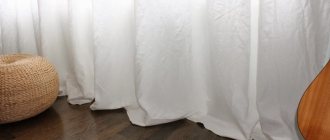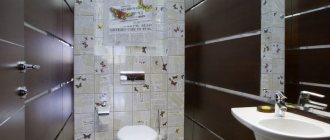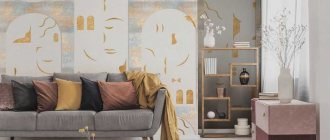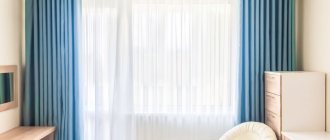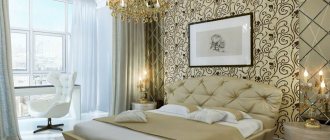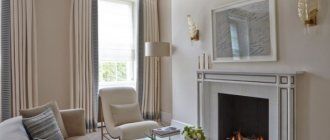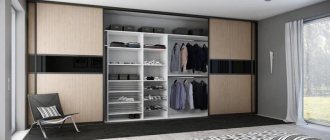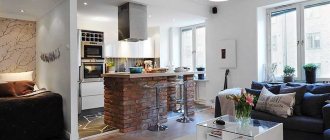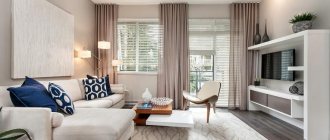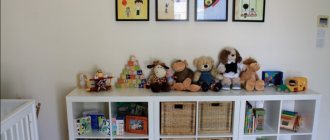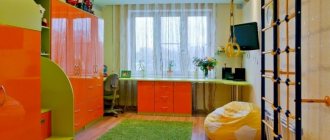A well-designed work area is the main task of parents. If previously it was customary to do homework in the kitchen, now having a “corner office” in the house is in the order of things. To ensure that all school supplies and other necessary things can be accommodated, shelves and cabinets are installed above the table. Using design techniques, you can make the room stylish and spacious.
A spacious desk with a functional shelf for things creates a comfortable workspace for a student
What is it and how does it work?
Decorative shelves for books and other items are perfectly placed in a niche above the table.
A shelf is a type of furniture without a front wall; a back wall may also be missing. This is a storage room for a child’s personal belongings, which include school supplies, cosmetics, a children’s library, and decorative items. They need to be installed near the desk so that everything is at hand. Hang at the height of the child to make it convenient to take objects.
Open shelves for books and toys in a children's room do not clutter up the space and are an excellent decorative element
Designers advise using open furniture. This will save space and improve visibility of things. Place a piece of furniture along the wall near the window. Windows will add natural light to the work area. The shelves are hung on fasteners, angles, or installed on the floor.
Mounting options for glass and other shelves
Wall shelf brackets
Shelves above the desk for a schoolchild
Every parent thinks about how to properly design a work area for their child. Modern students do not have room on their desks to accommodate all their notebooks, textbooks, various books, and all kinds of accessories in general.
This is where all sorts of storage system models come to the rescue. They are not only installed near the table, but also secured above the student’s workplace.
A well-designed work area is the main task of parents
Tips for choosing furniture
- If the room is small, then a corner shelf will do. You can place flower pots and decorative items on it. It can be hung on the wall or installed on the floor. The downside to such furniture is its small capacity.
- If your child loves to read, then a bookcase will do. For books, it is better to take ones with side walls. The material of the rack is iron. A big plus is its versatility - you can put books, flower pots, souvenirs.
- It is better to hang a console above the table. Photographs, pictures, cosmetics, etc. are placed on it. The console can be: single-tier, multi-level, corner, combined with a table, are suitable for office desks and computer tables. It is recommended to install a computer desk separately from a desk. They also differ in shape and design: there are rectangular, oval, narrow and wide.
- Diagonal ones are suitable for storing children's books.
To choose a shelf you need to take measurements of the room and desk. It is necessary to take into account the structure of the wall, the spaciousness of the room, and the height.
Manufacturing materials
Modern manufacturers use a variety of materials to make shelves. It can be chipboard, MDF, acrylic. However, traditional types of raw materials have not lost their relevance:
- Tree. Perhaps the most popular material. Solid wood shelves look great in any interior; they are especially often used in Scandinavian style or in loft-style rooms. In addition, wood has high environmental characteristics, which cannot be said about artificial materials made using glue. There are also some downsides - the cost of the shelves is quite high, since high-quality raw materials are always prestigious, environmentally friendly and expensive.
- Glass. Designs made from this material allow you to create a variety of design solutions based on a combination of the properties of a transparent surface and lighting. Glass is not affected by most aggressive environments, including moisture, is easy to clean and has increased wear resistance. The disadvantage of glass shelves is that they are fragile and traumatic.
- Metal. Steel products are simple and easy to use. Such shelves often have fastenings for installation on metal guides, which allows you to change the configuration of the product if necessary. The disadvantage is their low aesthetic properties, which is more than compensated by their functionality.
- Plastic. Modern manufacturing technologies for building materials make it possible to use plastic panels to make shelves with an almost unlimited choice of textures and colors. Plastic or vinyl products are environmentally friendly, often used in interiors in high-tech and modern styles, where there are non-standard shapes and curved lines. They have few disadvantages, one of them is that under heavy load the product can change shape or bend.
- Chipboard. Perhaps this material can be classified as the most budget-friendly. Chipboard shelves do their job well, but they are very fragile, especially at the fastening points, and have poor environmental performance due to the use of glue in the manufacture of the material.
- MDF. This raw material is most widely used for the manufacture of not only shelves, but also other furniture in Russia and Europe. Compared to chipboard, the material is stronger and more environmentally friendly. When applied, the coating can imitate many textures and have different colors. At the same time, MDF is a budget material and is relatively cheap.
The main characteristic of the material is environmental friendliness, which is especially important in families with children. Therefore, when choosing shelves based on price-quality ratio, emphasis should be placed in favor of the second indicator.
Wood Glass Metal
Plastic
MDF
Chipboard
How to do it yourself
Simple DIY Corner Bookshelves
Today there are no problems in choosing furniture for a desk; store consultants will help you choose the right furniture. For those who decide to make their own storage shelves, the following tips will help.
Choice of material: glass, wood, plastic, metal products.
For beginners, a horizontal console mounted on metal corners or legs is suitable. Lightweight U-shaped option with storage compartments.
An invisible shelf for books is suitable for DIY room decor
What do you need for work?
- Material
- Saw, hacksaw, grinder, glass cutter (depending on the material).
- Nails, screws, squares.
- Paint or varnish.
- Squares for measuring angles, ruler and pencil.
Tools for creating a DIY shelf
Work progress: Any construction begins with a drawing and taking measurements.
Scheme of a simple wall shelf with the required dimensions
All you need to do is apply the finished measurements to the material and cut it out.
Cutting boards for a homemade shelf
Sanding a board for a DIY shelf
Next, the parts are treated with paint or varnish. Suspended with nails, screws, squares or legs.
The process of assembling a homemade wooden shelf
It is also possible to embed the product into a wall. The method of fastening depends on the material of the product.
Assembled shelf after treatment with stain and varnish
A shelf is a place to store a child’s things and part of the interior. Various design solutions make it possible not only to make the piece of furniture comfortable and spacious, but also interesting.
Types of shelves
The variety of types of shelves today is very large. If we take as a basis the material from which the shelf is made, then they can all be classified as follows:
- Glass and mirror;
- Wooden (chipboard, MDF, plywood);
- Polymer and plastic;
- From other materials that can be combined with each other.
If we take the design, appearance, structure and method of fastening as a basis, we can distinguish the following types:
Wall mounted
Wall shelves supported by other stable furniture or the floor. A positive feature of such shelves is that their special design allows them to withstand quite a large load, which makes them indispensable assistants in the house when you need a place to store something large and heavy.
Most often they are used for all kinds of equipment or storing shoes in the hallway. These shelves take up minimal space, which is also a positive feature, especially for small apartments.
Sometimes, in order to make your interior design exceptional, it is not at all necessary to resort to the services of expensive specialists or buy exclusive and expensive furniture. After all, decorating the interior of a room is not a routine task, but the most creative process of transforming space. Therefore, sometimes, to give a room a certain individual style, the most ordinary and simple objects are enough, which with their presence will dilute the monotony of the interior, making it more dynamic and functional. Such elements are racks and wall shelves, when choosing which it is only important to take into account the harmony of their shapes and colors with the surrounding interior, without forgetting about their main functional purpose.
Back to school soon
After the first-grader's workplace is equipped, it is worth thinking about how and where he will sit during school lessons. It’s a good idea if the classroom is equipped with slanted desks or even desks that allow you to work both sitting and standing. These are used, for example, in schools working according to the “health-saving education” method of V.F. Bazarny. Alas, there are few such schools. Other criteria for assessing a child’s school workplace are the same as those at home. The desk and chair must be appropriate for the child’s height, and the classroom must be well lit.
Proper organization of a child’s workplace is, of course, very important. But, besides this, rest, sports, walks in the fresh air, and proper nutrition are important and necessary. The combination of these factors will allow the child to gain knowledge and maintain health, because being healthy is so great!
Source
Does a child need a computer?
Nowadays there is a computer in almost every home, and it is not a luxury, but a learning tool. If you decide to place a computer at your child’s workplace, you should not place it directly on the desk: this makes it very difficult to maintain the required distance from the eyes to the monitor. It is better to put a special corner computer table. This will protect the child’s vision and not clutter up the workspace of the desk with the monitor. By the way, it is worth remembering that the recommended norm for working on a computer for a child is from 15 minutes a day for a first-grader, to two approaches of 30-40 minutes for high school students. Well, or at least a fifteen-minute rest every hour of work.
At what height should book shelves be placed in a children's room?
In September my son will go to first grade. At what height should bookshelves be placed in the nursery to make it comfortable and safe for the child to do his homework?
Everything is absolutely individual and here it is not construction that comes to the fore, but genetics.
A seven-year-old child may be below 110 cm tall, or taller than 140 cm, and it’s even difficult to find an average height, because you won’t need it.
Shelves for books can be hanging, wall, or floor.
Shelves can be located above the table and even be structurally one with it (the table).
There is only one guideline and it is absolutely individual. Your child should calmly get a book from the top shelf.
But at the same time, do not rise on tiptoes and do not extend your arm to its full length.
You can choose the height of the shelf yourself.
Ask the child to stand up and stretch his arm up above his head, measure.
The distance from the shoulder to the fingertips was divided by two and subtracted from the size of the risk that is located on the wall.
This will be a convenient distance for the child, that is, he stands near the shelf with his arm extended to half and he can get a book from the top shelf.
We can only speak approximately.
For example, a child’s height is 120 cm, the distance from the floor to the top shelf is from 140 to 150 cm, this is quite normal.
In general, the whole situation is not entirely correct, children grow quite quickly and it is not worth “punching holes” in the walls with constant regularity.
In the end, the necessary books can be rearranged exactly in the place where the child can get them.
Well, practice shows the following:
Almost all the necessary information for the student is on the computer; textbooks are stored in the desk drawer at which the child does his homework.
If they need to get a book, children turn to their parents.
Calculating the necessary centimeters is often completely unnecessary; in the case of a child, children grow.
Source
Design ideas
To create a comfortable atmosphere, designers offer several interesting ideas:
- For young children, it is better to choose designs in the form of objects (car, plane, tree, cloud).
- Brightly colored shelves harmonize well with wallpaper in calm shades. They complement the overall style of the room.
- For small rooms, corner shelves or shelves around the window are suitable.
- Do not underestimate hanging options with belts or ropes. With their help you can create a unique composition.
- Children can decorate the white shelves themselves with special stickers. This will involve them in the process of decorating the room, and will also allow you to diversify the interior.
